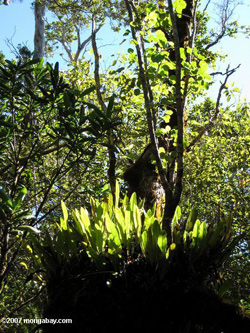Tropics are expanding
Tropics are expanding
NOAA
December 3, 2007
EDITOR’S SUMMARY: Climate change has caused a widening of Earth’s tropical belt, according to a new study published in a new scientific journal, Nature Geoscience. “Remarkably, the tropics appear to have already expanded — during only the last few decades of the 20th century — by at least the same margin as models predict for this century,” said the scientists who conducted the research.
The Earth’s tropical belt — approximately the area between the tropics of Cancer and Capricorn — has widened over the past quarter century as the planet has warmed, and could change precipitation patterns that would affect ecosystems, agriculture, and water resources, according to research by a NOAA scientist and colleagues. The findings are published today in the first edition of the new publication Nature Geoscience.
“We looked at how certain aspects of the structure and circulation of the atmosphere have been altered over the past few decades and how models predict they may change as the climate changes in the future,” said Dian Seidel, lead author and research meteorologist with NOAA’s Air Resources Laboratory in Silver Spring, Md. “We are seeing indications that a warming climate is associated with expansion of the tropical region toward the poles, and the rate of expansion that has occurred in recent decades is greater than projected by climate models to occur in the 21st century.”
Computer model simulations in several recent studies found that jet streams and the associated wind and precipitation patterns tend to move poleward under global warming. Some observational studies have already found a widening of the tropics by several degrees latitude since 1979.
 The tropics are expanding, but researchers say that affected areas are more likely to see desertification rather than the emergence of rainforests. |
The authors looked at five types of upper-air measurements, including satellite observations of ozone concentrations, satellite-based microwave observations of atmospheric temperature, and observations of the tropopause, the region between the stratosphere and the troposphere, by weather balloons and a combination of observations that provide a complete description of the atmosphere.
Seidel’s co-authors are Qiang Fu of the University of Washington, Department of Atmospheric Sciences, Seattle, Wash.; William J. Randel of the National Consortium for Atmospheric Research, Atmospheric Chemistry Division, Boulder, Colo.; and Thomas J. Reichler of the University of Utah, Department of Meteorology, Salt Lake City, Utah.
The authors note there are a variety of mechanisms that can be causing the expansion, such as warming sea surface temperatures and stratospheric ozone depletion. Other possibilities that have yet to be explored include changes in the El Niño Southern Oscillation system and stratospheric climate changes.
They also acknowledge that there are aspects of the observed changes that need to be explored in more detail, such as regional and seasonal characteristics of the widening.